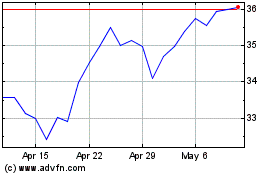Banks Releasing Loan Reserves Face Tricky Accounting Estimates as Economy Improves
May 10 2021 - 8:29AM
Dow Jones News
By Mark Maurer
Banks and other financial institutions are devising how to
release large loan reserves under an accounting rule that
complicates the task of calculating them.
To do so, executives at companies including JPMorgan Chase &
Co. and Citizens Financial Group Inc. are scrutinizing metrics such
as credit quality and loan growth to help estimate the level of
future reserves amid the continuing economic uncertainty.
Many lenders bulked up their loan reserves this time last year
to prepare for potential defaults during the onset of the pandemic,
cutting into profits. Banks' provisions for credit losses totaled
$61.91 billion in the second quarter of 2020, compared with $12.84
billion during the prior-year period, according to the Federal
Deposit Insurance Corp., a federal banking regulator.
Now, investors and analysts are increasingly questioning the
banks on when their reserves will go back to pre-pandemic levels.
But jumping the gun could be dangerous: Lowering reserves too
quickly and then needing to rebuild them could hurt companies'
credibility and reduce income, accountants and advisers say.
Under U.S. accounting standards, companies are required to
forecast expected losses as soon as a loan is issued. The rule,
known as Current Expected Credit Losses, or CECL, went into effect
for large public firms in January 2020, with some of them choosing
to delay implementing it for a year because of the pandemic.
Private and smaller public companies have until 2023 to adopt
CECL.
Companies previously didn't have to book losses until they had
evidence -- such as the default of a borrower -- that the losses
had actually occurred.
CECL particularly impacts financial institutions because loans
comprise a large portion of their assets. The standard also affects
nonfinancial companies with financial assets ranging from loans to
debt securities. Bankers say the rule makes company earnings more
unpredictable. The Financial Accounting Standards Board, which sets
U.S. accounting standards, however, has said the rule more closely
aligns companies' accounting with actual credit risks and provides
investors with more transparency.
The improved economic outlook and soaring markets are leading
banks to slash the funds they held for loan losses, thus boosting
profits. JPMorgan on April 14 said it freed up $5.2 billion in
funds it had allocated to cover soured loans, bringing its reserves
to $25.6 billion. The bank's loan assets totaled $1.01 trillion as
of March 31.
The bank released most of the $5.2 billion in its consumer
credit-card division because certain mortgage delinquencies remain
low and U.S. employment levels have improved, Chief Financial
Officer Jennifer Piepszak said on an earnings call. JPMorgan
declined to comment beyond its filing and the earnings call.
Executives are careful about the amount of reserves they hold
because they are unsure about where the economy is headed, said
Donald Fandetti, a managing director of equity research at Wells
Fargo & Co.'s securities division. The bank on April 14 said it
released about $1.7 billion, bringing its reserves to $18 billion
in the first quarter. "Everybody is leaving a bit of cushion," Mr.
Fandetti said.
Citizens Financial Group also lowered its reserves. The bank on
April 16 said it let out $298 million in the quarter ended March
31, compared with the $463 million it built up during the
prior-year period. Citizens said it made the move because of the
improved economic outlook. The bank's credit-loss provision was
$1.62 billion in 2020, up from an average of $352.3 million during
the previous four years.
The Providence, R.I.-based bank overrode the economic forecasts
it usually relies on from ratings firms and other external
providers to better incorporate economic uncertainty into its
reserve levels, CFO John Woods said. Those forecasts are highly
dependent on factors such as the efficacy of Covid-19 vaccines, Mr.
Woods said.
Citizens is weighing other scenarios to project credit losses,
such as slower vaccination rates and consumer spending, he said.
"That's where the judgment comes in to layer in additional reserve
requirements to deal with some of those contingencies," he
said.
Investors generally like it when banks bring down their reserves
because it frees up capital for lending and investments, said Janet
Pegg, an analyst at research firm Zion Research Group. Continuing
to hold high reserves could signal to the market that a company is
overly pessimistic about its loan book.
The FASB is considering whether to make changes to the standard.
For that, it is consulting companies, investors and other
stakeholders, and plans to host a roundtable discussion on May
20.
Firms that haven't had to implement the rule yet are also
watching closely. Texas Security Bank, a privately held
Dallas-based lender, is studying the techniques that big banks use
to determine their provision for credit losses, CFO Drew Keith
said.
"The big takeaway we have is that you do have to be careful with
the subjective part of it," he said, referring to forecasting
losses under the standard. Mr. Keith said he plans to consider a
mix of different economic forecasts, including those from research
firms Moody's Analytics, a subsidiary of Moody's Corp., and ITR
Economics.
Write to Mark Maurer at mark.maurer@wsj.com
(END) Dow Jones Newswires
May 10, 2021 08:14 ET (12:14 GMT)
Copyright (c) 2021 Dow Jones & Company, Inc.
Citizens Financial (NYSE:CFG)
Historical Stock Chart
From Mar 2024 to Apr 2024

Citizens Financial (NYSE:CFG)
Historical Stock Chart
From Apr 2023 to Apr 2024
